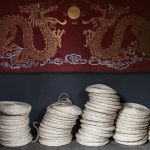In the grand tapestry of sustainable textiles, the threads of hemp, linen, and cotton weave a story of water usage that’s worth examining. While you might think linen offers a green alternative to cotton’s staggering consumption, the real comparison reveals more nuances. As you explore the water efficiency of these fabrics, you’ll uncover surprising insights that could influence your choices in eco-friendly fashion. What does this mean for the future of sustainable textiles?
Table of Contents
Key Takeaways
- Cotton has a significantly higher water footprint, requiring 10,000 liters per kg, compared to 500 liters for linen and 600 liters for hemp.
- Linen uses more water than hemp but less than cotton, with a requirement of 500 liters per kg.
- Hemp’s low water demand of 600 liters per kg makes it a more sustainable option than both linen and cotton.
- Linen’s growth period is 4 months, while hemp grows faster in just 3 months, enhancing its eco-friendliness.
- Sustainable farming practices can further reduce the water usage associated with all three textiles, promoting environmental health.
Water Efficiency of Hemp, Linen, and Cotton
When you compare the water efficiency of hemp, linen, and cotton, it becomes clear that not all fabrics are created equal.
Hemp stands out as the champion, needing considerably less water to grow. You’ll find that it requires about half the water cotton does, making it a much more sustainable choice.
Linen, derived from flax, also shows impressive water efficiency, needing less than cotton but more than hemp. If you’re focused on minimizing water usage, hemp is your best bet, while linen offers a solid alternative.
Cotton, on the other hand, demands a staggering amount of water, often leading to serious environmental concerns.
Ecological Impact of Textile Production
When you consider the ecological impact of textile production, it’s essential to look at the water footprint of each material.
Cotton, linen, and hemp each have unique water usage patterns, influenced by farming practices.
Water Footprint Comparison
Although all textiles require water for production, the amount varies greatly between linen, cotton, and hemp. Understanding their water footprints can help you make more informed choices. Here’s a quick comparison:
| Textile | Water Usage (liters per kg) | Growth Time (months) |
|---|---|---|
| Linen | 500 | 4 |
| Cotton | 10,000 | 5 |
| Hemp | 600 | 3 |
As you can see, cotton has a much higher water footprint compared to linen and hemp. Linen requires much less water, making it a more sustainable option. Hemp, while still low, offers a faster growth time, contributing to its eco-friendliness. Choosing wisely impacts not only your wardrobe but also the planet.
Sustainable Farming Practices
Sustainable farming practices play an essential role in minimizing the ecological impact of textile production. When you choose linen, cotton, or hemp, look for brands that prioritize organic methods, which use fewer chemicals and promote soil health.
Crop rotation and polyculture can enhance biodiversity, helping to maintain balanced ecosystems. Water management techniques, like rainwater harvesting and drip irrigation, reduce water usage and prevent soil erosion.
By supporting sustainable practices, you’re making a conscious decision to protect the environment. Additionally, local sourcing can cut down on transportation emissions, further lowering your carbon footprint.
Water Needs in the Cultivation Stage
When you look at the water needs for growing these three fabrics, you’ll notice some striking differences.
Hemp requires much less water compared to cotton, which has a reputation for its high water consumption.
Linen falls somewhere in between, presenting a moderate option for those concerned about water usage in textile production.
Hemp’s Low Water Demand
Hemp stands out among textile crops due to its remarkably low water demand during cultivation. Unlike many other plants, hemp can thrive with minimal irrigation, making it an eco-friendly choice for sustainable agriculture.
When you grow hemp, you’ll notice it requires about half the water that cotton does. This low water requirement not only contributes to conservation efforts but also helps maintain soil health.
Hemp’s deep root system allows it to access moisture from deeper layers, reducing the need for frequent watering. As a result, you can cultivate this versatile crop in various climates, even in drier regions.
Choosing hemp means supporting a more sustainable textile industry, ultimately benefiting both you and the environment.
Cotton’s High Water Usage
Cotton cultivation demands a staggering amount of water, making it one of the thirstiest crops in the textile industry. On average, it takes about 7,000 to 29,000 liters of water to produce just one kilogram of cotton.
This immense water requirement stems from its growth cycle, which typically lasts around five to six months. You might be surprised to learn that many cotton-growing regions face water scarcity, putting additional pressure on local resources.
Farmers often rely on irrigation, which can lead to over-extraction of water from rivers and aquifers. With global cotton production on the rise, understanding its high water usage is essential for making sustainable choices in your clothing and textile purchases.
Linen’s Moderate Water Needs
While cotton’s water consumption raises significant concerns, linen offers a more moderate alternative regarding water needs during cultivation.
You’ll find that linen, derived from the flax plant, requires less water overall. This plant thrives in well-drained soil and can tolerate periods of drought, making it resilient in various climates.
In fact, flax typically needs about 50% less water than cotton, which means it puts less strain on local water resources. Additionally, linen’s cultivation often involves less intensive irrigation compared to cotton farming.
By choosing linen, you’re opting for a fabric that not only benefits your wardrobe but also supports more sustainable agricultural practices.
Production Processes: Water Usage Comparison
When comparing the production processes of linen, cotton, and hemp, you’ll find significant differences in water usage. Cotton requires an astonishing amount of water, often around 10,000 liters per kilogram, largely due to its irrigation-heavy cultivation.
In contrast, hemp is a more sustainable option, needing only about 2,500 liters per kilogram. Linen, derived from flax, also has a moderate water requirement, roughly 5,000 liters per kilogram. This makes hemp the most water-efficient crop among the three.
In addition to water consumption, consider factors like soil quality and climate conditions, as they can further influence the overall sustainability of each fiber.
Land Requirements for Hemp, Linen, and Cotton
Although the land requirements for hemp, linen, and cotton vary greatly, understanding these differences is essential for making sustainable choices.
Hemp is highly efficient, needing about half the land compared to cotton to produce the same amount of fiber. This makes it an attractive option for eco-conscious consumers.
Linen, derived from flax, requires moderate land but is still more efficient than cotton.
Cotton, on the other hand, demands extensive land and resources, often leading to deforestation and soil depletion.
By choosing hemp or linen over cotton, you can considerably reduce your environmental footprint.
When considering fabric options, factoring in land usage helps you make informed, sustainable decisions that align with your values.
Economic Aspects of Water Usage in Textiles
Understanding the economic aspects of water usage in textiles can greatly impact your purchasing decisions. When you consider water-intensive fabrics like cotton, it’s not just about the price tag.
Here are a few points to ponder:
- Cost of Production: Higher water use can drive up production costs.
- Sustainability: Eco-friendlier options like linen and hemp often reflect better long-term value.
- Market Trends: Consumers increasingly demand sustainable products, influencing prices.
- Brand Reputation: Companies investing in sustainable practices may command higher prices due to consumer preference.
- Water Scarcity: Regions facing water shortages may see fluctuating costs for water-heavy crops.
Future Perspectives on Sustainable Textiles
As consumers become more aware of the environmental impact of their choices, the demand for sustainable textiles is set to rise. You’ll likely see a surge in innovative materials that prioritize eco-friendliness.
Brands are now exploring biodegradable fabrics, recycled fibers, and low-water alternatives like hemp and linen. As technology advances, you’ll benefit from improved manufacturing processes that reduce waste and energy consumption.
Expect transparency in sourcing and production as companies endeavor to meet your growing expectations for ethical practices. Collaborative efforts between designers, manufacturers, and environmental organizations will shape the future landscape of textiles.
You’ll find that sustainable options won’t just contribute to a healthier planet but also offer unique aesthetics and functionalities, making them an appealing choice for your wardrobe.
Consumer Awareness and Demand for Sustainable Options
How aware are you of the impact your clothing choices have on the environment? Many consumers are starting to recognize that opting for sustainable fabrics can greatly reduce water usage and ecological harm.
As awareness grows, so does the demand for eco-friendly options like linen and hemp. You can contribute to this movement by making informed choices:
- Research brands that prioritize sustainability.
- Look for certifications indicating eco-friendly practices.
- Choose versatile pieces that last longer.
- Support local businesses that use sustainable materials.
- Spread the word about the benefits of sustainable textiles.
Innovations in Water Efficiency for Textile Production
While traditional textile production often consumes vast amounts of water, innovative technologies are now paving the way for more efficient methods.
You’ll find companies employing techniques like waterless dyeing and closed-loop systems, drastically reducing water usage. Cutting-edge processes, such as digital printing, minimize water waste by applying ink directly onto fabric without the need for extensive rinsing.
Additionally, advancements in fiber recycling allow for the reuse of materials, further decreasing water demands. By choosing brands that prioritize these innovations, you not only support sustainable practices but also contribute to a healthier planet.
As these technologies continue to evolve, the textile industry is making strides toward a future where water efficiency becomes the norm, not the exception.
Frequently Asked Questions
How Does the Water Usage of Linen Affect Its Overall Environmental Impact?
Linen’s lower water usage greatly reduces its environmental impact. By choosing linen over more water-intensive fabrics, you contribute to conserving water resources, promoting sustainable practices, and ultimately supporting a healthier planet for future generations.
Are There Any Certifications for Sustainable Linen Production?
When you think of sustainable practices, consider certifications like Oeko-Tex and GOTS. They guarantee your linen’s produced ethically, using environmentally friendly methods. So, when you shop, look for these labels to support responsible choices.
What Regions Are Best Suited for Growing Hemp and Linen?
You’ll find that hemp thrives in temperate climates, particularly in North America and Europe. Linen grows best in regions with cooler temperatures, like France and Belgium, where soil conditions support high-quality flax production.
How Can Consumers Support Sustainable Textile Practices?
When you wrap yourself in a soft, eco-friendly blanket, you’re embracing sustainable choices. Support sustainable textile practices by choosing organic materials, reducing waste, and seeking brands that prioritize ethical production. Your choices make a difference!
What Are the Long-Term Benefits of Using Hemp Over Cotton?
When you choose hemp over cotton, you’re embracing a sustainable option. Hemp requires less water, grows faster, and enriches the soil, contributing to healthier ecosystems. You’ll support eco-friendly practices that benefit both you and the planet.
- Where to Buy Men’s Corduroy Pants: Top Stores and Tips - July 5, 2025
- A.M.I. Corduroy Jacket: The Stylish Fabric Choice for Fall Fashion - July 5, 2025
- Where to Buy Corduroy Trousers: A Fabric Lover’s Guide - July 5, 2025







